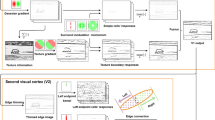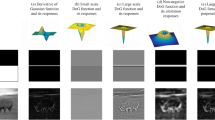Abstract
Edges are key components of any visual scene to the extent that we can recognise objects merely by their silhouettes. The human visual system captures edge information through neurons in the visual cortex that are sensitive to both intensity discontinuities and particular orientations. The “classical approach” assumes that these cells are only responsive to the stimulus present within their receptive fields, however, recent studies demonstrate that surrounding regions and inter-areal feedback connections influence their responses significantly. In this work we propose a biologically-inspired edge detection model in which orientation selective neurons are represented through the first derivative of a Gaussian function resembling double-opponent cells in the primary visual cortex (V1). In our model we account for four kinds of receptive field surround, i.e. full, far, iso- and orthogonal-orientation, whose contributions are contrast-dependant. The output signal from V1 is pooled in its perpendicular direction by larger V2 neurons employing a contrast-variant centre-surround kernel. We further introduce a feedback connection from higher-level visual areas to the lower ones. The results of our model on three benchmark datasets show a big improvement compared to the current non-learning and biologically-inspired state-of-the-art algorithms while being competitive to the learning-based methods.





Similar content being viewed by others
Explore related subjects
Discover the latest articles, news and stories from top researchers in related subjects.Notes
The source code and all the experimental materials are available at https://github.com/ArashAkbarinia/BoundaryDetection.
References
Akbarinia, A., & Parraga, C. A. (2016). Biologically plausible boundary detection. In: Proceedings of the British Machine Vision Conference (BMVC), BMVA Press.
Angelucci, A., & Shushruth, S. (2014). Beyond the classical receptive field: Surround modulation in primary visual cortex. In J. S. Werner & L. Chalupa (Eds.), The new visual neurosciences (pp. 425–444). Cambridge: MIT Press.
Arbelaez, P., Maire, M., Fowlkes, C., & Malik, J. (2011). Contour detection and hierarchical image segmentation. IEEE Transactions on Pattern Analysis and Machine Intelligence, 33(5), 898–916.
Bertasius, G., Shi, J., & Torresani, L. (2015a). Deepedge: A multi-scale bifurcated deep network for top–down contour detection. In Proceedings of the IEEE Conference on Computer Vision and Pattern Recognition, pp. 4380–4389.
Bertasius, G., Shi, J., & Torresani, L. (2015b). High-for-low and low-for-high: Efficient boundary detection from deep object features and its applications to high-level vision. In Proceedings of the IEEE International Conference on Computer Vision, pp. 504–512.
Briggs, F., & Martin, U. (2014). Functional properties of cortical feedback to the primate lateral geniculate nucleus. In J. S. Werner & L. Chalupa (Eds.), The new visual neurosciences (pp. 315–322). Cambridge: MIT Press.
Canny, J. (1986). A computational approach to edge detection. IEEE Transactions on Pattern Analysis and Machine Intelligence, 6, 679–698.
Comaniciu, D., & Meer, P. (2002). Mean shift: A robust approach toward feature space analysis. IEEE Transactions on Pattern Analysis and Machine Intelligence, 24(5), 603–619.
Cour, T., Benezit, F., & Shi, J. (2005). Spectral segmentation with multiscale graph decomposition. In Computer Vision and Pattern Recognition, 2005. CVPR 2005. IEEE Computer Society Conference on, IEEE, vol. 2, pp. 1124–1131.
Dalal, N., & Triggs, B. (2005). Histograms of oriented gradients for human detection. In Computer Vision and Pattern Recognition, 2005. CVPR 2005. IEEE Computer Society Conference on, IEEE, vol. 1, pp. 886–893.
Díaz-Pernas, F. J., Martínez-Zarzuela, M., Antón-Rodríguez, M., & González-Ortega, D. (2014). Double recurrent interaction v1-v2-v4 based neural architecture for color natural scene boundary detection and surface perception. Applied Soft Computing, 21, 250–264.
Dollár, P., & Zitnick, C. L. (2015). Fast edge detection using structured forests. IEEE Transactions on Pattern Analysis and Machine Intelligence, 37(8), 1558–1570.
Dollar, P., Tu, Z., & Belongie, S. (2006). Supervised learning of edges and object boundaries. In Computer Vision and Pattern Recognition, 2006. IEEE Computer Society Conference on, IEEE, vol. 2, pp. 1964–1971.
Domingos, P. (2012). A few useful things to know about machine learning. Communications of the ACM, 55(10), 78–87.
Felzenszwalb, P. F., & Huttenlocher, D. P. (2004). Efficient graph-based image segmentation. International Journal of Computer Vision, 59(2), 167–181.
Field, D. J., Golden, J. R., & Hayes, A. (2014). Contour integration and the association field. In J. S. Werner & L. Chalupa (Eds.), The new visual neurosciences (pp. 627–638). Cambridge: MIT Press.
Freeman, J., Ziemba, C. M., Heeger, D. J., Simoncelli, E. P., & Movshon, J. A. (2013). A functional and perceptual signature of the second visual area in primates. Nature Neuroscience, 16(7), 974–981.
Fu, H., Wang, C., Tao, D., & Black, M. J. (2016). Occlusion boundary detection via deep exploration of context. In Proceedings of the IEEE Conference on Computer Vision and Pattern Recognition, pp. 241–250.
Gao, S., Yang, K., Li, C., & Li, Y. (2013). A color constancy model with double-opponency mechanisms. In Proceedings of the IEEE International Conference on Computer Vision, pp. 929–936.
Georgeson, M. A., & Meese, T. S. (1997). Perception of stationary plaids: The role of spatial filters in edge analysis. Vision Research, 37(23), 3255–3271.
Grigorescu, C., Petkov, N., & Westenberg, M. A. (2003). Contour detection based on nonclassical receptive field inhibition. IEEE Transactions on Image Processing, 12(7), 729–739.
Hansen, T., & Neumann, H. (2008). A recurrent model of contour integration in primary visual cortex. Journal of Vision, 8(8), 8–8.
Heeger, D. J. (1992). Normalization of cell responses in cat striate cortex. Visual Neuroscience, 9(02), 181–197.
Hess, R. F. (2014). Spatial scale in visual processing. In J. S. Werner & L. Chalupa (Eds.), The new visual neurosciences (pp. 595–615). Cambridge: MIT Press.
Hoiem, D., Stein, A. N., Efros, A. A., & Hebert, M. (2007). Recovering occlusion boundaries from a single image. In Computer Vision, 2007. ICCV 2007. IEEE 11th International Conference on, IEEE, pp. 1–8.
Hupe, J., James, A., Payne, B., Lomber, S., Girard, P., & Bullier, J. (1998). Cortical feedback improves discrimination between figure and background by v1, v2 and v3 neurons. Nature, 394(6695), 784–787.
Ichida, J. M., Schwabe, L., Bressloff, P. C., & Angelucci, A. (2007). Response facilitation from the suppressive receptive field surround of macaque v1 neurons. Journal of Neurophysiology, 98(4), 2168–2181.
Kapadia, M. K., Westheimer, G., & Gilbert, C. D. (1999). Dynamics of spatial summation in primary visual cortex of alert monkeys. Proceedings of the National Academy of Sciences, 96(21), 12073–12078.
Kivinen, J. J., Williams, C. K., Heess, N., & Technologies, D. (2014). Visual boundary prediction: A deep neural prediction network and quality dissection. AISTATS, 1, 9.
Koenderink, J. J., & Van Doorn, A. J. (1982). The shape of smooth objects and the way contours end. Perception, 11(2), 129–137.
Landy, M. S. (2014). Texture analysis and perception. In J. S. Werner & L. Chalupa (Eds.), The new visual neurosciences (pp. 639–652). Cambridge: MIT Press.
LeCun, Y., Bottou, L., Bengio, Y., & Haffner, P. (1998). Gradient-based learning applied to document recognition. Proceedings of the IEEE, 86(11), 2278–2324.
Loffler, G. (2008). Perception of contours and shapes: Low and intermediate stage mechanisms. Vision Research, 48(20), 2106–2127.
Malach, R., Amir, Y., Harel, M., & Grinvald, A. (1993). Relationship between intrinsic connections and functional architecture revealed by optical imaging and in vivo targeted biocytin injections in primate striate cortex. Proceedings of the National Academy of Sciences, 90(22), 10469–10473.
Marr, D., & Hildreth, E. (1980). Theory of edge detection. Proceedings of the Royal Society of London B: Biological Sciences, 207(1167), 187–217.
Martin, D., Fowlkes, C., Tal, D., & Malik, J. (2001). A database of human segmented natural images and its application to evaluating segmentation algorithms and measuring ecological statistics. In Computer Vision, 2001. ICCV 2001. Proceedings. Eighth IEEE International Conference on, IEEE, vol. 2, pp. 416–423.
Mély, D. A., Kim, J., McGill, M., Guo, Y., & Serre, T. (2016). A systematic comparison between visual cues for boundary detection. Vision Research, 120, 93–107.
Morrone, M. C., & Burr, D. (1988). Feature detection in human vision: A phase-dependent energy model. Proceedings of the Royal Society of London B: Biological Sciences, 235(1280), 221–245.
O’Herron, P., & von der Heydt, R. (2011). Representation of object continuity in the visual cortex. Journal of Vision, 11(2), 12–12.
Papari, G., & Petkov, N. (2011). Edge and line oriented contour detection: State of the art. Image and Vision Computing, 29(2), 79–103.
Parraga, C. A., & Akbarinia, A. (2016). Colour constancy as a product of dynamic centre-surround adaptation. Journal of Vision, 16(12), 214–214.
Poirier, F., & Wilson, H. R. (2006). A biologically plausible model of human radial frequency perception. Vision Research, 46(15), 2443–2455.
Prewitt, J. M. (1970). Object enhancement and extraction. Picture Processing and Psychopictorics, 10(1), 15–19.
Shapley, R., & Hawken, M. J. (2011). Color in the cortex: Single-and double-opponent cells. Vision Research, 51(7), 701–717.
Shen, W., Wang, X., Wang, Y., Bai, X., & Zhang, Z. (2015). Deepcontour: A deep convolutional feature learned by positive-sharing loss for contour detection. In Proceedings of the IEEE Conference on Computer Vision and Pattern Recognition, pp. 3982–3991.
Shushruth, S., Ichida, J. M., Levitt, J. B., & Angelucci, A. (2009). Comparison of spatial summation properties of neurons in macaque v1 and v2. Journal of Neurophysiology, 102(4), 2069–2083.
Shushruth, S., Nurminen, L., Bijanzadeh, M., Ichida, J. M., Vanni, S., & Angelucci, A. (2013). Different orientation tuning of near-and far-surround suppression in macaque primary visual cortex mirrors their tuning in human perception. The Journal of Neuroscience, 33(1), 106–119.
Spillmann, L., Dresp-Langley, B., & Tseng, Ch. (2015). Beyond the classical receptive field: The effect of contextual stimuli. Journal of Vision, 15(9), 1–23.
Spratling, M. W. (2013). Image segmentation using a sparse coding model of cortical area v1. IEEE Transactions on Image Processing, 22(4), 1631–1643.
Thériault, C., Thome, N., & Cord, M. (2015). Cortical networks of visual recognition. In G. Cristóbal, L. Perrinet, & M. S. Keil (Eds.), Biologically inspired computer vision: Fundamentals and applications. Wiley-VCH Verlag GmbH & Co. KGaA.
Tomasi, C., & Manduchi, R. (1998). Bilateral filtering for gray and color images. In Computer Vision, 1998. Sixth International Conference on, IEEE, pp. 839–846.
Tzvetanov, T., & Dresp, B. (2002). Short-and long-range effects in line contrast integration. Vision Research, 42(22), 2493–2498.
Van De Weijer, J., Gevers, T., & Gijsenij, A. (2007). Edge-based color constancy. IEEE Transactions on image processing, 16(9), 2207–2214.
Walther, D. B., Chai, B., Caddigan, E., Beck, D. M., & Fei-Fei, L. (2011). Simple line drawings suffice for functional mri decoding of natural scene categories. Proceedings of the National Academy of Sciences, 108(23), 9661–9666.
Watt, R., & Morgan, M. (1985). A theory of the primitive spatial code in human vision. Vision Research, 25(11), 1661–1674.
Wei, H., Lang, B., & Zuo, Q. (2013). Contour detection model with multi-scale integration based on non-classical receptive field. Neurocomputing, 103, 247–262.
Wilson, H., & Wilkinson, F. (2014). Configural pooling in the ventral pathway. In J. S. Werner & L. Chalupa (Eds.), The new visual neurosciences (pp. 617–626). Cambridge: MIT Press.
Xie, S., & Tu, Z. (2015). Holistically-nested edge detection. In Proceedings of the IEEE International Conference on Computer Vision, pp. 1395–1403.
Yang, K., Gao, S., Li, C., & Li, Y. (2013). Efficient color boundary detection with color-opponent mechanisms. In Proceedings of the IEEE Conference on Computer Vision and Pattern Recognition, pp. 2810–2817.
Yang, K. F., Li, C. Y., & Li, Y. J. (2014). Multifeature-based surround inhibition improves contour detection in natural images. IEEE Transactions on Image Processing, 23(12), 5020–5032.
Yang, K. F., Gao, S. B., Guo, C. F., Li, C. Y., & Li, Y. J. (2015). Boundary detection using double-opponency and spatial sparseness constraint. IEEE Transactions on Image Processing, 24(8), 2565–2578.
Zeki, S. (1993). A vision of the brain. Oxford: Oxford University Press.
Acknowledgements
We would like to thank Dr. Xavier Otazu, members of the NeuroBiT Group at the Centre de Visió per Computador, Dr. Thorsten Hansen, and anonymous reviewers of the manuscript for their thoughtful insights and comments.
Author information
Authors and Affiliations
Corresponding author
Additional information
Communicated by Edwin Hancock, Richard Wilson, Will Smith, Adrian Bors and Nick Pears.
This work was funded by the Spanish Secretary of Research and Innovation (TIN2013-41751-P and TIN2013-49982-EXP) and the CERCA Programme from the Generalitat de Catalunya.
Rights and permissions
About this article
Cite this article
Akbarinia, A., Parraga, C.A. Feedback and Surround Modulated Boundary Detection. Int J Comput Vis 126, 1367–1380 (2018). https://doi.org/10.1007/s11263-017-1035-5
Received:
Accepted:
Published:
Issue Date:
DOI: https://doi.org/10.1007/s11263-017-1035-5




